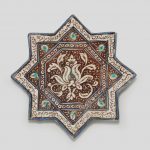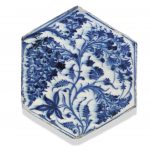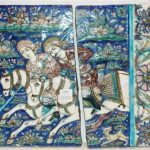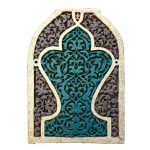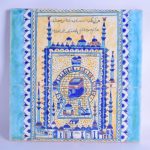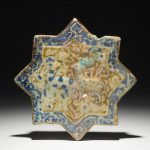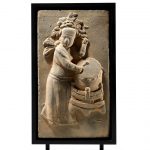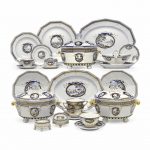Price guide to antique and vintage Islamic tiles.
Between the 8th and 18th centuries, the use of ceramic glaze was prevalent in Islamic art, usually assuming the form of elaborate pottery. Tin-opacified glazing was one of the earliest new technologies developed by the Islamic potters. The first Islamic opaque glazes can be found as blue-painted ware in Basra, dating to around the 8th century. Another contribution was the development of fritware, originating from 9th-century Iraq. Other centers for innovative ceramic pottery in the Old world included Fustat (from 975 to 1075), Damascus (from 1100 to around 1600) and Tabriz (from 1470 to 1550). Reference: Wikipedia
A Kashan lustre pottery star tile Persia 13th/ 14th Century of eight-pointed stellar form, decorated in cobalt blue, turquoise and brownish gold lustre on a cream ground with a central octagonal panel containing a lotus flower surrounded by a band of circle motifs, the corners with vegetal motifs, the border with a band of inscription 21.2 cm diameter
Sold for £ 4,375 inc. premium at Bonhams in 2018
A MAMLUK HEXAGONAL POTTERY TILE DAMASCUS, SYRIA, CIRCA 1420-50 The white ground painted in cobalt-blue with a large and elegant swaying spray with two flower-bearing branches 7 ½in. (19cm.) across
Sold for GBP 10,625 at Christies in
Islamic Pottery Tile In two pieces, molded in relief with hunting companions on a blue ground, surrounded by blossoming flowers, a partial border to one tile decorated with birds and blossoms. Height 17 inches (43 cm), width 21 inches (53 cm).
Originally one piece broken into two (long time ago.) Chips to rim, largest approximately 3 inches below dog dog on right. Horizontal crack on right side through border, approximately 5 inches chip repair at top, 3/4 inches.
Sold for $2,375 (includes buyer’s premium) at Doyle New York in 2008
A rare and monumental Islamic Timurid tile panel, Transoxiana, late 14th/early 15th century of arched form, with deeply carved floral and foliate designs decorated with turquoise, white, lavender-blue and aubergine glazes, the turquoise-glazed centre with a tri-lobed arch containing scrolling arabesques, split palmettes and lotus blossoms, the blue-glazed spandrels carved en suite, between white borders 59 cm. X. 43 cm
Sold for $3,000 at Anders Auction Inc in 2018
AN ISLAMIC POTTERY TILE depicting a Mecca scene upon a turquoise ground, flanked by calligraphy. 25 cm square.
Sold for £450 at Hannam’s Auctioneers Ltd in 2018
An Islamic luster glaze relief-decorated star tile, Kashan, Iran, 13th C. L.: 20,5 cm
Sold for €850 at Rob Michiels Auctions in 2018
Early Islamic mosaics in Iran consist mainly of geometric decorations in mosques and mausoleums, made of glazed brick. Typical turquoise tiling becomes popular in 10th-11th century and is used mostly for Kufic inscriptions on mosque walls. Seyyed Mosque in Isfahan (AD 1122), Dome of Maraqeh (AD 1147) and the Jame Mosque of Gonabad (1212 AD) are among the finest examples. The dome of Jame’ Atiq Mosque of Qazvin is also dated to this period.
Tumurid turquoise-glazed muqarna. First half of the 15th century, Shah-i-Zinda
The golden age of Persian tilework began during the reign the Timurid Empire. In the moraq technique, single-color tiles were cut into small geometric pieces and assembled by pouring liquid plaster between them. After hardening, these panels were assembled on the walls of buildings. But the mosaic was not limited to flat areas. Tiles were used to cover both the interior and exterior surfaces of domes. Reference: Wikipedia
